So rather than go at it piecemeal, here's the whole deal from the beginning- the most sensible place to start, usually. Dockett visited this past weekend, riding down from Tokyo in high style on the ultrafast bullet-train. You can read his account by clicking on the link over to the right that reads "Dockett's Blog", or just clicking here. That's his story, I'll let him tell it.
Mine begins, as so many do here in Japan, in the rain. I met Dockett in Kusatsu station, the little train depot in the next town over, and ferried him back to the house for the grand tour after dinner at my favorite little Ramen shop. This place is great- I think I've mentioned it previously- the owner was studying to be a pastry chef in New York, has one heck of a story to sell you with your heaping bowl of Ramen, and decided to come back home to Ritto to live out his later days. He was born in Kyoto, so he had some tips as to where we ought to go this weekend. Ever-helpful, he came out from behind the counter (shock!) to draw big red circles on his map, showing us the MUST SEE spots. Armed with knowledge and full of cheap eats, we depart.
Back at the mansion, I show an astonished Dockett around. This house is NOT SMALL. I think I've made this pretty clear. I don't know that I made it clear enough, so I'll say it again. I am UNCOMFORTABLE with how big this house is. I can't keep track of all the space. After boring him to tears with little architectural touches, we decided to go tour the town via bicycle. My bike's a giant- literally, that's the brand- and the previous teacher was kind enough to leave a mountain bike behind that I've dubbed "the Loaner." It's "the Loaner" for two reasons: One, it's pretty hard to get around town on foot without dedicating hours to hiking around the hills of Ritto, and two, it's a piece. The handlebars aren't on too tight, the brakes don't "work" in the conventional sense of the word, and it was until this weekend infested with spiders.
We cleaned it up a bit, and set out to adventure. Didn't get too far- just back to Kusatsu, to show him the covered Shotengai (old-style shopping district) and train station plaza, where students usually gather to hold impromptu outdoor concerts/breakdancing practice. Since panhandling's illegal in this country, they just do it for fun- which is awesome, in all sorts of ways. Unfortunately, as this story begins in the rain, it was too wet both for breakdancing and for guitarists. I did get fuzzy picture of the old 'n busted mechanical clock outside the station:

It's a kinda creepy mechanical number, with dancing animals and music that plays on the hour. I'm not sure what song. I don't think I want to know.
After showing him around the Kusatsu area a bit, we decide to call it an early night in hopes of getting a head start on the next day.
Ha Ha. Without work to wake up for, I sleep until ten. We don't get on the road until eleven, and as such hit Kyoto around noon. It's raining buckets, so we duck into an am/pm and buy some four-dollar umbrellas. The thing is, we considered bringing umbrellas. There were TWO INSTANCES where I looked at the sky, walked back into the house, grabbed my umbrella, and decided against bringing it. I figured it wouldn't rain ALL DAY. I was a fool.
That aside, I show Dockett out to Hongwanji Temple and East Hongwanji, the second having been built to draw attention away from the first in a questionable political move by the Shogunate. Seems the first one was getting too many followers, so the Shogun of the time built the second to split up the power base. This move, while it probably seemed brilliant, just gave the Buddhists another place of worship- and a larger congregation.
Whoops.
After Hongwanji, we hike (for quite awhile- Kyoto AIN'T SMALL) to Toji Temple. Toji's the temple everyone thinks of when they think of Kyoto. It's the one with the big ol' pagoda- five tiers of funerary fun. In addition to one impressive pagoda, it also has two HUGE halls filled with some really impressive Buddhist statuary. Unfortunately, they've been classified as objects of Great Historical Significance, and as such pictures are forbidden. Not just photographs- there's also a sign forbidding sketching in the halls. Literally, it says "No Sketching" in three languages. I really, really wanted a picture.
In a little museum just oustide of the temple grounds proper, there were four fire-damaged clay statues of the Terrifying Generals (signs of the Buddha's divine wrath against sin, sayeth the ever-informative brochure) that stood easily ten feet tall. The clay was cracked and scorched, and the faces were twisted beyond recognition. They were really cool. They too could neither be sketched nor photographed.
It seems that the fire didn't reach within the temple grounds, as the main halls were untouched and the pagoda still stood. It's possible they were reconstructions, but the apparent age of the things seemed to rule out that possibility. The support pillars inside the hall are so old that they're starting to crack from the pressure- in a few thousand years, when these halls crumble, it's going to make a heck of a noise.
 This is the second of the halls- in the background, you can see the pagoda. A unique feature of this temple complex is the relative lack of ravens- the Buddhist monks feed the birds, and as such every other temple I've visited is patrolled by a flock of ravens that make themselves known the moment I enter the grounds. This temple, by contrast, is owned by the pigeons. Less dangerous, sure, but pigeon calls lack a certain atmospheric flair that a cloud of beating black wings provide.
This is the second of the halls- in the background, you can see the pagoda. A unique feature of this temple complex is the relative lack of ravens- the Buddhist monks feed the birds, and as such every other temple I've visited is patrolled by a flock of ravens that make themselves known the moment I enter the grounds. This temple, by contrast, is owned by the pigeons. Less dangerous, sure, but pigeon calls lack a certain atmospheric flair that a cloud of beating black wings provide.I'm a sucker for little touches. There are plenty of beautiful pictures of these pagodas- so here's some more stuff you usually don't see:

The first is a pair of rain-soaked tourists providing size reference for this gargantuan thing. It's the highest pagoda in Japan. The pamphlet tells me it's burned down four times after being struck by lightning- hence the giant lightning rod up top, to make sure the same thing doesn't happen a fifth time. There are four Buddhas inside, but it's all locked up tight. Here's the security:
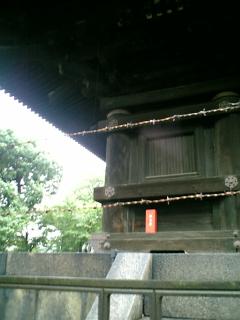 That's right. Barbed wire. That red thing's a fire extinguisher- they're not screwing around with this pagoda. Four times is enough.
That's right. Barbed wire. That red thing's a fire extinguisher- they're not screwing around with this pagoda. Four times is enough.To be fair, the current incarnation of this pagoda has stood since 1644. That's a pretty good streak- it's older than my country. The first one was built in 826.
After the pagodacrawl, we toured the temple grounds, and were confronted once again by the genius fish. Koi in this country KNOW that people mean food, and will hang out near the shore if you pass by. It's pretty cool- you walk up to a pond, and in a minute or so the water just in front of you will be filled with koi. Fish on demand.
We stop for ice cream. This is important, and must be blogged. Ice cream is always an event.
Behind the big halls full of esoteric Buddhist statuary, there's a smaller, newer temple complex. We duck through that and out into the street- leaving Toji through an opposite exit than we entered. With infinite wisdom and forethought, we decide to "see what's down this street".
We wander for hours, lost, in the alleyways and backstreets of Kyoto. In a strange way, it's scenic- places like these streets are the negative space of cities. They're where people really live- sandwiched under train tracks, in narrow streets, over and under and around shops and cleaning services. Temples and pagodas are what they WANT you to see- these places are here because they're necessary, not because they're attractive, and that makes them fun to explore.

This underpass eventually leads us under the train tracks and through to the other side, where we find a huge, industrial fish market that a) smells strongly of halibut and b) nearly spells our certain doom. The front end loaders and trucks don't care if you're six feet tall. They just know you're not supposed to be there, and as such carry on as if you're not. This is all well and good until the place you are is the place they want to be.
A terrifying fifteen minutes later, we emerge next to a train station. There are two choices here- we can board the train and take the sucker's way out, or we can walk to the subway stop (many blocks away). Having read this much, you already know what we did next. There was nothing else to do.
My favorite Japanese expression translates closely as "It can't be helped" or "That's the way it is", with a strong connotation of "Oh well, so it is." In standard Japanese, it's shikata ga nai. Down here in the Kansai region, they just say sha'nai.
So we walk. Sha'nai.

On the way, we find this sign. BONK! Look out for bikes.
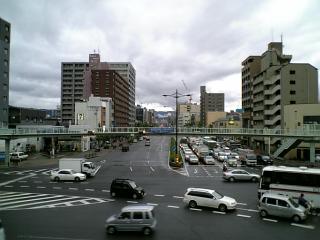
We also find Route 1- the same road that runs through Ritto. Should it become necessary, I can now hike home.

Dockett, incidentally, takes more pictures than I have ever seen anyone take... ever. He wins the prize- I think the longest his hand left his camera all day was the fifteen minutes we were sprinting down the fishmarket alley- and I KNOW it was killing him not to take a few.
Next, we finally stumble across a subway station and bop up to the old Imperial Palace. The palace is closed, so we only get as far as the inner gate.
Now, that's probably a bit of a misnomer. The inner gate is probably a solid 800 meters from the outer gate, and it's all in a straight line up a broad gravel path. It makes perfect sense- should an army invade, the Emperor has a good twenty minutes to prepare while said army runs down this ridiculously long path, and should they arrive with any fight left in them they are better men than I. It's discouraging- you keep getting closer, and the castle keeps getting further away. Upon finally arriving, we find everything locked up and a pair of very friendly guards around a side gate smilingly barring entry. Sha'nai.
After the Imperial Wall, we head out to Sanjo Keihan. It's the young folks' district, home of such quirky establishments as "Bar, isn't it?" and the "Pig and Whistle", as well as the shrines and temples that remind you that you're in Kyoto. Dinner, drinks at the Pig, and one very creepy American customer later, we end up in an actual Irish pub (Pig and Whistle being sort of "All the British Isles"), with a bartender whose brogue is in fact rich and sweet. I'm not sure if his name's Finnegan, but it ought to be.
The band here's an interesting mix- two Japanese folks on pennywhistle and guitar, and one ponytailed, mustachioed Western man decked out in Native American gear playing a bodhran (Traditinal Celtic Drum). The cultural catchalls here are AMAZING.
We grab an early(ish) train home, and wake up at a more reasonablle time the next day to explore Ritto. Dockett gets better pictures of my hometown than I do. I show him Ritto Jr. High, and Hayama Jr. High (my current workplace), as well as a few sights around Ritto.

Most notably, Lady Liberty (in daylight!).
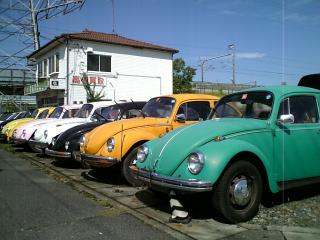
The Beetle Dealership!

I considered picking this one up- it cried "Take Me Home"... but my contract forbids the operation of a motor vehicle during the course of my duties as a teacher.
Pity.
So we poked around Ritto for awhile- I showed him Ritto station, and the concert hall where the choral competition took place- and Dockett said to me:
"I want to see a mountain."
Now, we're surrounded by mountains. Up here, we're MADE out of mountains.
"No, up close."
So, I think, why not? I really didn't have anything else planned that day- why not go on a spontaneous hike in the hills without supplies nor food nor prior planning?
So we go. We decide to climb THIS ONE.

The big one, on the left. It looks close. Really, it's quite far. It's in Yasu. Yasu's at least two towns over, and beyond a big river. The mountain is just so big it looks close. Do we pay that any heed?
No. Here we are in the parking lot of a 7-11 stocking up on drinks and energy before tackling this beast.

At the base of the mountain is this monument to a set of ruins. I'm not quite sure what it says. Here's Dockett, pondering.

We decide to let ancient mysteries lie and see how far up the mountain we can get. A little ways in, we find an abandoned shrine.
 It's a little creepy, but there are kids playing on the mountain, and a woman searching frantically for her lost child. Don't worry, she found him. Not to be bested by little kids, we decide then and there to climb all the way to the top.
It's a little creepy, but there are kids playing on the mountain, and a woman searching frantically for her lost child. Don't worry, she found him. Not to be bested by little kids, we decide then and there to climb all the way to the top.Which, upon reflection, was an awesome idea. The name of this mountain is Mount Mikami- Three Peaks Mountain. It's... a vertical kilometer up. It was a fun climb- there are essentially always two ways around any of the given challenges- one long, gentle grade, and one path straight up. Between the two of us, we made sure no path was left unturned. I like to hurl myself at stupid risks.
Nearly to the top, there's a fissure that evidently brings you good luck if you shimmy through it.
 As noted, I'm always a sucker for personal injury possibilities, so in I go.
As noted, I'm always a sucker for personal injury possibilities, so in I go.
Luck attained, we continue to the top.
 After a breathtaking view, ANOTHER shrine, and a chance meeting with a doctor who had a residency in Troy for a year, we descend. On the bike ride back, we find this monstrosity.
After a breathtaking view, ANOTHER shrine, and a chance meeting with a doctor who had a residency in Troy for a year, we descend. On the bike ride back, we find this monstrosity.
I'm really not sure what's going on here, but it looks really cool.
After our long bike journey back, we stop at KFC. Now, I'm not a fan of Kentucky Fried Chicken in the states, but hey... when in Japan, experience the local culture, right?
So Japanese Kentucky Fried Chicken is exactly the same as American KFC. It's just as greasy. It's just as fatty. But here, on a diet of healthy fish and rice, it's DELICIOUS. Also, the service in all of these fast-food restaurants is amazing. They really go out of their way to make you feel like a priviliged guest, even when you're just in KFC or McDonalds. Another cultural note- there's no tipping in this country. None. It's just not done. So they go absolutely crazy to try and make sure you're comfortable... and you have no way to reward the staff. I say thank you, loudly in both Standard and Kansai (which always gets a laugh), but I never feel like I'm doing enough.
After that, back to the house to take a break. Fast forward an hour, and we're both incredibly bored... so back to Kusatsu! We chill for awhile in a coffee shop, doing EXACTLY what we would have done had we been back in the States, and call it a night. It is wonderfully surreal to sit in a Starbucks in Japan with people you know from America. One could almost forget where one was, save for the stares and the fact that all the background conversation is in Japanese.
Day 3: Otsu. I've been to Otsu just once before, and that was for the Eeyanka Matsuri- the South American Festival described in detail earlier. So I figure the park by the lake will be cool, and that's about it.
No, evidently Otsu is as close as you can get to Michigan this far away from America. It's like Traverse City plus Japan. It's a little, bustling, interesting town full of cool little stuff you didn't expect to find, but you're really happy you did. It was the capital for awhile, and every weekend it seems they're throwing another festival to commemorate SOMETHING. Example: We missed the big Otsu Festival, with floats and such, by one day. This weekend, they're throwing another festival, this one for middle school students. It's a party town- a very traditional, very Japanese party town. We wandered the shoreline for awhile, and Dockett noticed on one of the ubiquitous maps the "Shiga Prefectural Martial Arts Gym". So we check it out, and wander in. Nobody stops us, which is practically an invitation in Shiga, so we wander further...
And find ninjas. Literally, traditional Japanese archers, with the huuuuge longbows and interesting uniforms. They all look to be high school kids, with a few collegiate types about, and so we sit down and watch. It is amazingly cool. I really, really want to learn- there's a precise, methodical nature to the process, almost like a dance. The actual firing of the arrow seems an afterthought- they pay so much attention to the pattern of drawing the bow, aiming, and letting go that I can't help but think they're clockwork automata...
Until they notice us, and then when they're not on the firing range it's all smiles and waves. The class breaks to rush out to say hello to us ("THESE WESTERNERS- THEY SPEAK JAPANESE!") and we chat for a moment before they duck out and return to practice.
After the archery, I didn't think it could get cooler. What's cooler than Zen archery?
Samurai.
Real, metal-sword-wielding guys (and a few girls)- a whole room full of them, going through another set of precise, careful movements. I suppose that precision and care are pretty essential here... they are swinging REAL SWORDS. I thought this was banned in the Meiji era. I guess I thought wrong. I resolve to find out if I can learn this stuff, so we stop by the front desk. To my surprise, they seem perfectly happy to have me show up, and it looks pretty cheap.
Catch, though, is that all the classes meet while I'm at work. Darn. There must be other places to study this stuff... this has become my new mission.
After the martial arts gym, we go explore another temple, and are pressed into paying a couple bucks for a guided tour. Seems this is an important temple- the Tenno visits here every time he comes to Otsu, which seems to happen once per Tenno. I'm not sure who the Tenno is, but he's got a door leading into the temple that only he can use, so I suppose that's worth something.
The little museum attached to this temple is notable for one very interesting reason: It contains two scrolls that I haven't seen anywhere else. One details a group of monks repelling invaders by passing gas. Another is a very graphic depiction of all sorts of violence inflicted on some very innocent-looking figures. Both fart jokes and gore existed BEFORE modern media- it's not television that's killing culture, it's culture killing itself just as it has been for millenia. I'd just like that noted.
So we move on to the bigger temple next door; Miidera Temple. In the course of exploring this temple, we find an ancient Buddhist library.

It's really cool- it's a big rotating octagon lined with stacks of books. It's easily twenty feet tall. My mother is a librarian- this picture is for her.
Then, we find another pagoda. It's pagoda-tastic.
My favorite part of this temple? The huuuge graveyard. There are two graveyards, in fact. One is large, and rectangular, and new, and made of paved gravel. The other follows a narrow path that leads up into the mountain. I check out the one that involves the climbing, and Dockett heads into the big, orderly graveyard.

My trip up that path still gives me shivers. The graves that line the path are all different ages and styles, and don't really follow a set pattern. As the path winds upwards, there's a small clearning- a grove of new-growth trees- and in the center of the grove is a single grave. The clouds broke for a moment when I got there, and there was a moment- just one- where I didn't feel alone in the least. It wasn't an unpleasant feeling- it could almost be described as the same feeling as listening to your steps echo around an empty church hall. So I enjoyed the moment, took a few pictures, and got the heck out of there.
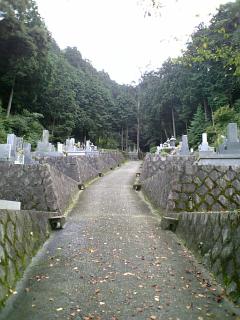
All my pictures of that path are blurry but one.
 In that one, there's a white splotch across the gravestone that I didn't see when I was up there.
In that one, there's a white splotch across the gravestone that I didn't see when I was up there. It's weird.
It's weird.Then, I met up with Dockett in the other graveyard, snapped a few pictures, and we moved on.

Note the two red kanji on this grave. I have no idea what they mean. I might be doomed.
Further up the mountain, we find the last piece of the temple, and note with dismay that we have climbed YET ANOTHER mountain this weekend. We didn't set out to climb any, and now we've climbed two.


Sha'nai.
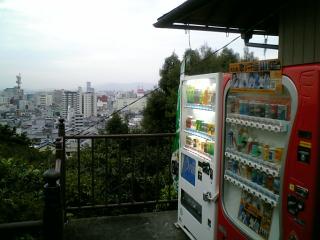
In a remote temple on the top of a mountain, there are plenty of handy vending machines. I love Japan.
So we wander back down the mountain, past another few shrines and down another Shotengai. We find the office for the Otsu festival, the Shiga Prefectural Offices and Courthouse, and a few other government buildings.

Nothing left now but to walk back to the train station, and say our goodbyes. My half of the story ends where it began- Kusatsu. I followed Dockett out to Kyoto station, and stopped in Kusatsu on the way home. The college students were playing guitar again, so I hung out with them awhile. I walked up, and the only English I heard was "Ohh! Sensei's back!"- and that's not even all English. They're good folks, though- they always make sure to play some American songs, and want me to sing for 'em. Yeah. Right.
I'm going to have to pay Tokyo another visit before Dockett's term ends- I can think of one more mountain we need to climb.
Fuji.
pax.

1 comment:
Hi, I'm ji-sun,won.
Japan is very nice country.
But, do you know the country that placed by Japan? It's name is Korea. Why don't you go to the Korea?
P.s> I'm sorry. I'm not good at English. I know nothing about grammar, but I'll try to write. So,plese understand me^^;
Post a Comment